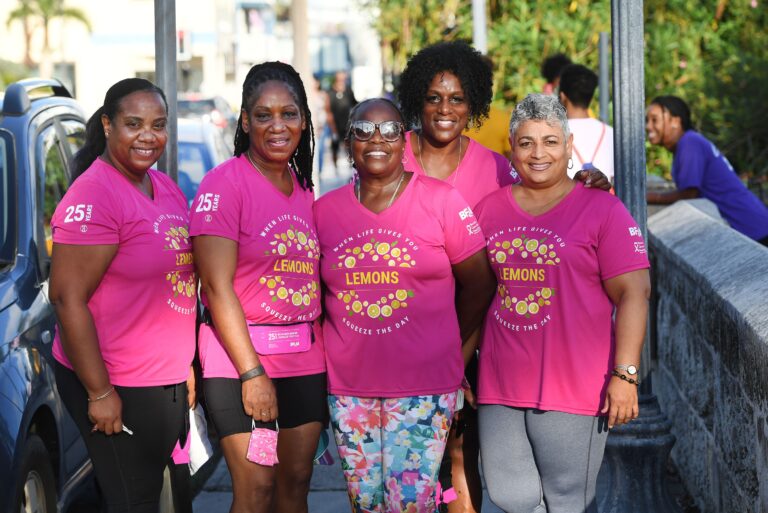October is breast cancer awareness month and Bermuda Cancer and Health Centre is gearing up for the 28th Annual BF&M Breast Cancer Awareness Walk on Wednesday, October 16, at Barrs Bay Park.
Breast cancer is the most common cancer found in women in Bermuda, and this year there is an ambitious goal.
“We have a mammography machine that is coming to the end of its life,” explained Deborah Titterton Narraway, CHC’s chief marketing and fundraising officer.
“The breast cancer walk and everything we do in October will go towards that.”
October’s events usually raise around $200,000. The goal for this year however, is $400,000.
While a lot of fundraising happens during October, it is only one month in a busy year full of events. These include the Relay for Life, AXA XL Man on the Run 5K, MOvember Bermuda, St Baldrick’s and a host of other initiatives driven by organisations and individuals who have either been affected by cancer themselves, know someone affected, or simply care.
CHC has no government funding, but it receives insurance reimbursements. There is, however, no co-pay and no patient is turned away if they are uninsured or underinsured.
“No one should have to pay for their cancer care. They should be focused on wellness, not how to pay for something,” continued Ms Titterton Narraway. This is why their fundraising initiatives are so crucial.
Each year, the centre raises around $1.6 to $1.8 million, $1.1 million of which is restricted to the Equal Access fund. This fund covers care costs for those not adequately insured. Ideally, however, the annual sum raised needs to be $2.5 million.
“That would cover equal access, plus our education and wellness programmes, which are not fully funded at the moment. We run them anyway,” she explained.
“What that would leave us is any revenue we make off our clinical services, we could be investing in the future.”
Like the mammography machine, other valuable equipment needs to be replaced from time to time. There are also unexpected costs: for example, if a machine is not working, that patient has to go abroad for treatment instead.
“All we need is one hiccup with radiation therapy,” she said. “We have been very fortunate that our machine has stayed up and running.
“But, should a hurricane cause an issue, whether you can no longer physically access the building or we are without electricity for more than a certain period of time, we would be putting people on airplanes and sending them to Boston.
“For those who are not insured, we would cover all that. That would change our cash flow tremendously. We try and keep a healthy reserve for that.
“Every piece of equipment has a life span. Our radiation machine is coming towards the end of that life span. We will have to replace that equipment.”
They have also outgrown their building and need to acquire more space.
Most of the funds raised come from the community and this is why their events are so crucial.
“When you look at our events, that’s all peer to peer fundraising,” explained Ms Titterton Narraway. “We get people to register for the event. They’re the ones who go out and host fundraisers or send their URL to friends and family.”
The largest fundraiser by far is the Relay for Life, which takes place in May. This year, nearly 5,500 people helped to raise more than $800,000 and Ms Titterton Narraway puts its success down to the fact that it involves the whole community.
“Cancer doesn’t discriminate and cancer doesn’t sleep, which is why it’s an overnight event. It effects everybody, from families, community clubs, businesses.”
The guests of honour are the survivors, which makes it particularly poignant, especially as many have previously keep their cancer diagnosis to themselves.
“Every year, we’re surprised at the number of people who come in and say they don’t know someone with cancer. We ask them why they’re there.
“It’s a community event and they keep coming back now, year after year, because they may have walked in the gate not knowing someone with cancer, but when they watch the people who walk the track and wear the survivor sashes, they’re usually surprised to see a colleague, a neighbour, who maybe hasn’t made it public outside of that event.”
Two more big events focus on cancers that affect men. The AXA XL Man on the Run 5k will take place on November 10 and MOvember, throughout the month of November. The latter is where men fundraise by growing a ‘MO-ustache or beard’ for 30 days. Last year, MOvember Bermuda raised more than $26,000 towards both the Equal Access fund and prostate cancer education and prevention.
2023’s AXA XL Man on the Run 5K raised over $36,000, which went towards free men’s health screening events, men’s health presentations and financial subsidisation for radiation therapy.
The CHC also works with the United States-based St Baldrick’s Foundation, which helps fund research into childhood cancer cures, and 10 per cent of the funds raised from Bermuda events stay on the island. Those funds go towards their SunSmart programme, which is primarily aimed at children.
While these large events make up the bulk of CHCs fundraising successes, there is a particular need for “unrestricted fundraising”, where funds can be used wherever needed, such as running costs or personal care products for patients. The Annual Appeal supports this.
Whether it’s restricted or unrestricted funds, every little helps. Tiles can be bought for their Commemorative Tile Wall, women can host Girls Night In where the cost of a night out is donated, or you can simply organise your own fundraising initiative.
There are also very personal donations. Ms Titterton Narraway shared a story about a man who lost his brother to cancer: “They were avid golfers. He now donates $50 for every birdie he makes.
“The donation doesn’t have to be big, but the continued support is what keeps us going.”
For more information visit cancer.bm

